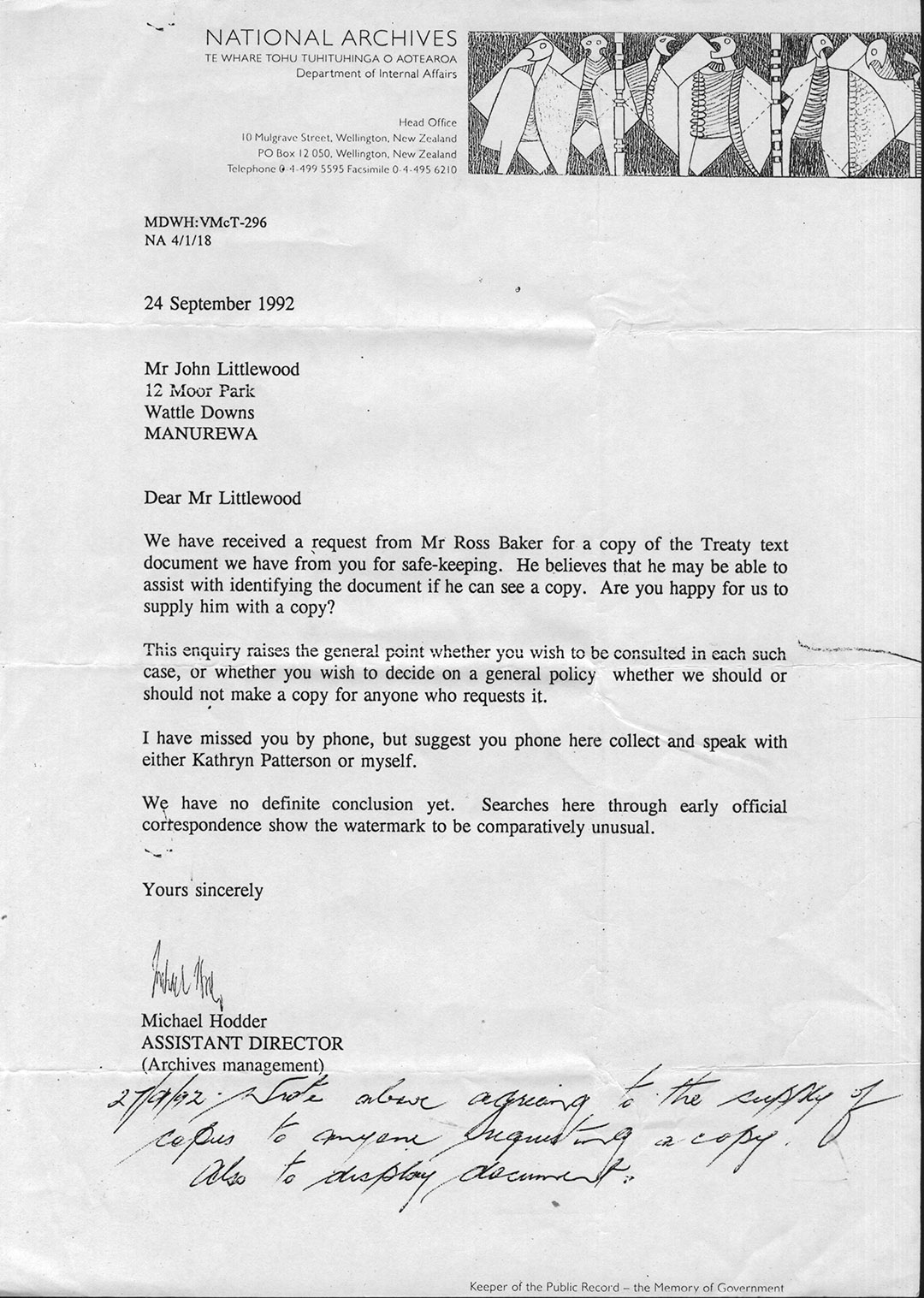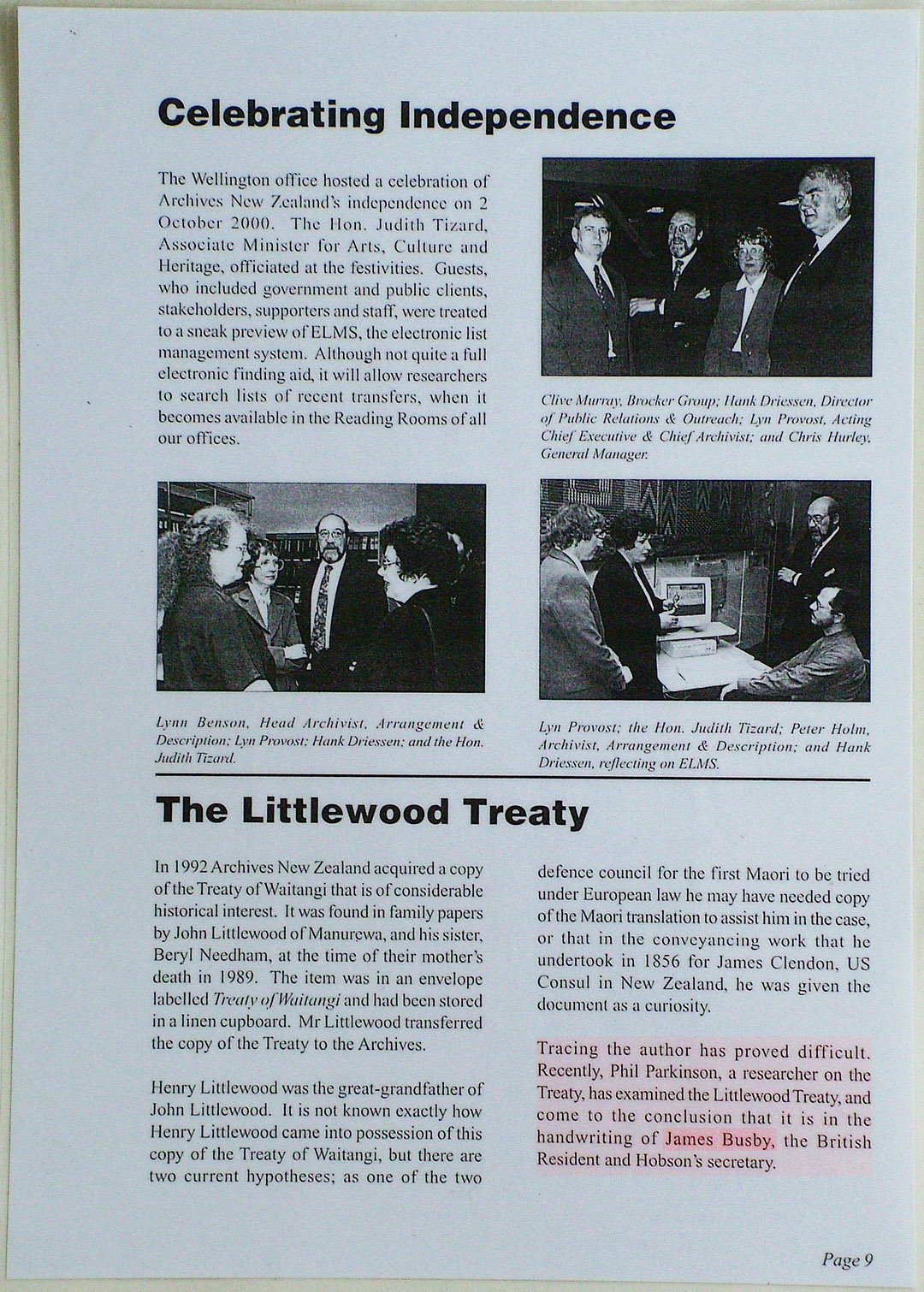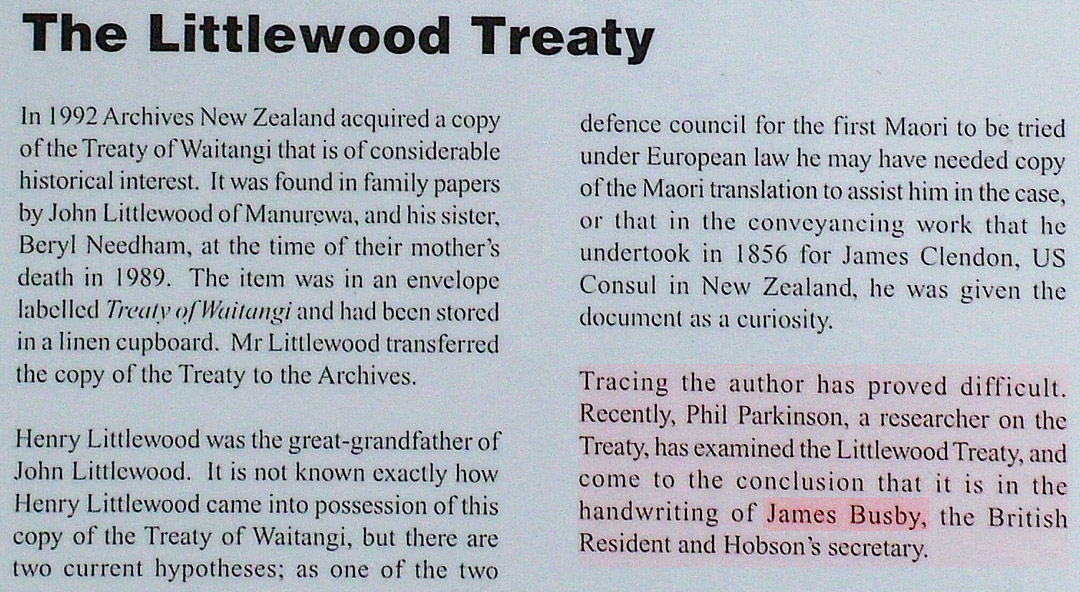The Littlewood Treaty, The True English Text of the Treaty of Waitangi, Found
Chapter: Précis 1 2 3 4 5a, 5b, 5c, 5d, 5e 6 7 8 9 10 11 12 13 14 15 16 17 18 19 20 Lord Normanby's Brief Additional Resources
Chapter 3
THE PEDIGREE OF THE TREATY DOCUMENT FOUND BY THE LITTLEWOOD FAMILY
Every newly found historical document has to have a plausible pedigree to establish its authenticity beyond reasonable doubt. In the case of the Treaty of Waitangi document, found amidst old family papers of the Littlewood family of Pukekohe, South Auckland in 1989, the pedigree proves to be impeccable.
One of the family forebears was Henry Littlewood, whose date
of birth can be assumed to be the 25th of May, 1812, in the town of Old
Swindon, Worchester, England. This is the registered date of Henry’s
christening and it was, apparently, the custom of the church recorders to
write the true birth date into the register at the time of a child’s
christening. Henry’s parents were Benjamin Littlewood and Esther Badger,
who appear to have been very well to do and financially blessed estate owners.
There were 7 children born to Esther Littlewood and Henry was the youngest.
As a young adventurous man in his twenties, Henry was, apparently, already
in Australia and for the next few years would commute between New Zealand
and Australia on several occasions. The date of his first passage from England
to Australia is unknown. In answer to enquiries concerning Henry Littlewood,
Dr. Phil Parkinson of the National Library wrote on 24/12/03:
‘You also expressed interest in the associations of Henry Littlewood. Very little is known of him. He appears to have been at the Bay of Islands in 1838. The situation in which he came to prominence was as defence counsel for Maketu during his trial for murder in 1842 (Hodder to Littlewood, 14 September 1992 in the Littlewood file at Archives New Zealand, 4/1/189). The Alexander Turnbull Library has no further information about him, apart from a notice of his death, which occurred at Auckland on 5 September 1864, aged 52 (Australian and New Zealand Gazette no. 687 (24 December 1864) p. 415).’
Henry Littlewood’s great-grandson, John Littlewood has amassed the following information from his own family records or through the endeavours of private researchers:
It would appear that Henry was in a bit of strife and cooling his heels in New Zealand by the middle of 1840, as the following article was published in the Colonial Gazette on the 17th of June 1840. He’d just turned 28.
‘A Mr. Henry Littlewood, an attorney of Sydney had decamped to New Zealand. Reason - having cheated his creditors’ (See Colonial Gazette, pg. 403, Auckland Public Library).
The more traceable trail of Henry Littlewood picks up in late
January 1842, when Henry and eleven other gentlemen were in Auckland, New
Zealand and obliged to present proof of their certification and competency
to practice law.
On the 26th of January, 1842 a notice appeared in the official Gazette,
which called upon all persons who claimed to be barristers to appear on
the 31st of January 1842 before the Chief Justice with proof of competence.
The first twelve men who signed the roll included Henry Littlewood (see
Cooke ed. Portrait of a Profession, 1969, A/W. Reed, Wellington.
The New Zealand Herald and Gazette newspaper published the following article on the 5th of February 1842, under the title of Domestic Intelligence:
‘Law - On Monday the following Gentlemen attended at the office of Mr. Thomas Braithwaite, Registrar of the Supreme Court, for the purpose of producing to the Chief Justice due proof of their respective qualifications according to the Supreme Court Ordinance, Session 2, No. 1:- Charles Babbington Brewer, barrister; Augustus Thompson, barrister; Frederick Whitaker, solicitor; Thomas Edward Conry, solicitor; and Henry Littlewood, solicitor, Esquires’.
Family oral history includes a rumour passed down that Henry Littlewood was somehow involved in the signing ceremony of the Treaty of Waitangi, but this cannot yet be substantiated by documents. Dr. Phil Parkinson of the National Library places him in the Bay of Islands in 1838, the location where the treaty was later signed in February 1840. He was certainly in New Zealand, again, by June of 1840, only four months after the treaty was signed and might have been present as an officiating legal solicitor, helping out during the treaty proceedings, although there’s no known record of any such participation. Family oral history states that he retained, in his possession, original documents related to the Treaty of Waitangi.
It would appear that he remained in New Zealand for several years from 1840 onwards, but family oral history speaks of him returning to England for a short period, at some stage prior to 1847.
Henry Littlewood returned back to New Zealand on the ship Saghalien on the 22nd of November 1847. He was married in Auckland on the 17th of January 1848, to Mary Hill, daughter of James Carlton Hill. The ceremony took place at St. Paul’s Church in Auckland, conducted by the Reverend J.F. Churton and the church records listed his profession as solicitor. Either he had met Mary Hill before or abroad and cultivated a relationship or this was a whirlwind romance, resulting in marriage only seven weeks after returning to New Zealand.
Henry Littlewood’s father-in-law later purchased a large tract of land overlooking the Manukau Harbour in Auckland. James Carlton Hill was apparently speculating on the fact that the city development would move in that direction. Because of the dangers posed to sailing ships entering through the Manukau Heads across the treacherous and ever-shifting sand bar, the more popular port of call was on the eastern side of the city through the wider expanse and more placid, Hauraki Gulf. The area purchased by Hill eventually became known as the suburb of Hillsborough and James Carlton Hill, built a home there, which still stands.
Mary Littlewood (née. Hill) had five children to Henry Littlewood, including twin boys. The children were Harry, Frederick, Carlton & Inglis (twins) and Esther, the only girl.
Henry Littlewood continued to practice law in New Zealand and his name appears on jury lists for the years 1854, 1855 and 1858. In the New Zealander newspaper a notice appears, dated August 9th 1849 which says, ‘Mare strayed near Epsom Church. Reward if returned to Littlewood, Epsom or to Mr. Hill, Auckland’.
At some point the Littlewood’s purchased land in Russell, near to the location where the Treaty of Waitangi was signed. The plot of land was said, by the Littlewood family descendants, to be the same area where the main school of Russell Township was eventually built and now stands. Henry’s name appears on the Bay of Islands’ Electoral Roll for the year 1857, where his profession is listed as solicitor. During this period of time former U.S. Consul, James Reddy Clendon engaged the legal services of Henry Littlewood.
Henry Littlewood died in Auckland at the relatively young age of 52 and the cause of death was listed as “intemperance”. Death occurred on the 5th of September 1864 (newspaper obituary) although the church register records his death as the 7th. Henry’s funeral was conducted from St. Mark’s Church in Remuera and it is thought that he was buried at the Symond’s Street Cemetery. Many of the graves of this cemetery had to be moved to alternative locations for reburial when the motorway was built over 100-years later and it is thought that Henry’s grave came into this relocated category. It’s possible that his remains were removed to Chamberlain Park Cemetery in Onehunga suburb.
A CASE OF TOO LITTLE TOO LATE
A discerning public, with its ever-present cells of deep digging research moles, can quickly ascertain facts if there is sufficient access to information. When it came to the Littlewood Treaty document, however, the public and research community, generally, were denied any clear samples for close scrutiny and analysis. They had to settle for some fleeting glimpses of an elusive something in a couple of 1992 television news-clips and, beyond that, little or nothing else seems to have ever been available.
A good example of the kind of bureaucratic run-around researchers had to contend with when trying to get clear copies of the Littlewood Treaty is found in the way that Ross Baker, historian for the One New Zealand Foundation, was treated.
John Littlewood received a letter from the National Archives
dated the 24th of September 1992 in which a Mr. Michael Hodder asked if
it would be alright to supply a copy of the Littlewood Treaty, which had
been requested by One New Zealand Foundation historian, Ross Baker.
The following is Mr. Hodder’s letter:

This is the letter John Littlewood received from Michael Hodder, which
prompted him to grant overall, general permission for anyone requesting
a copy of the Littlewood Treaty to have one supplied, to display as they
wished. John’s handwritten notation is seen at the bottom.
John Littlewood and his extended family were very agreeable to allow copies of their document to be distributed to any and all who requested them and wrote a general, blanket consent back to the Archives in a letter of 27/9/92.
Despite leaving John Littlewood with the distinct impression that copies would be made available, on request, to any researcher asking Archives for one, Ross Baker was refused a copy, even after John Littlewood had given his personal approval to fulfil that particular, individual request. Mr. Baker writes with justified irritation:
‘I wrote to the National Archives and requested a copy of the Littlewood document. The reply to me from the National Archives was that, “it was too valuable and delicate to photocopy, as the process would damage it”. This is a lie, as several photocopies were made, by Archives, in 1992 for the owners and distributed to members of the Littlewood family. In 2003 researcher, Martin Doutré, was allowed by John Littlewood to make his own photocopies of the document directly from one issued to the family by the National Archives in 1992’.
Even though the National Archives had both hard-copy and electronic files of the Littlewood Treaty on hand and didn’t need to disturb the original, they deliberately and unreasonably fobbed Ross Baker off with this lame excuse. Mr. Baker was left with no other option available to him than to try and source a copy directly from the Littlewood’s.
An Auckland member of the One New Zealand Foundation, therefore, approached John Littlewood directly with the request and John took time out to have a duplicate made from the first-generation one supplied to him by Archives in 1992. By this means, Rotorua based, Mr. Baker was able to acquire a sufficiently good copy for research purposes.
After careful analysis he quickly came to the conclusion that this document was, indeed, the long sought after, final English draft of the Treaty of Waitangi and stated these conclusions in his 1992 book, He Iwi Tahi Tatou. It is also interesting to note that this book was sent to all MPs. In total, 6000 books were distributed throughout NZ, including to libraries and government departments. Mr. Baker repeated his call for a full investigation into the significance of the Littlewood Treaty in his 1998 book, From Treaty to Conspiracy.
It would appear that between 1992 until the end of 2003, there were very few, if any, copies of the Littlewood Treaty made available to the public from sources inside the National Archives. Because of silence emanating from that quarter on any matters arising out of the Littlewood Treaty, the 1989 discovery finally lapsed from public memory. It seems doubtful that anyone, other than John Littlewood and a few die-hard stalwarts like Ross Baker, retained more than vague recollections of some treaty related news incident back in the early 90’s. For most of us, whatever it was, way-back-when, the interminable silence had taken effect and the all-too-brief Littlewood Treaty splash across the headlines had long-since receded from memory.
An innocent and almost unnoticed, throwaway statement appeared in an obscure, end-of-the-year 2000, in-house Archives publication, which blandly said:
‘Recently Phil Parkinson, a researcher on the treaty, has examined the Littlewood Treaty and come to the conclusion that it is in the handwriting of James Busby, the British Resident and Hobson’s secretary’.
Excuse me, but what was that you just said about
James Busby???


So there you have it after years of waiting with bated breath. No brass
bands and baton-twirling majorettes; no pomp and circumstance or shouting
from the rooftops. Just a thin throw away statement in a thin, throw away,
Archives newsletter, circulated to a reasonably insulated readership.